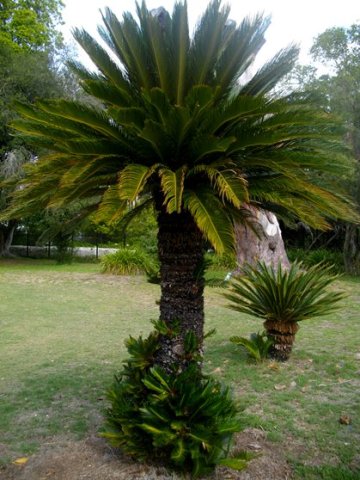Encephalartos

Encephalartos species are both spermatophytes (seed-bearing plants) and gymnosperms (cone-bearing plants). The genus forms part of the Zamiaceae family of dioecious plants growing main or tuberous roots and stems borne either below or above ground. These dicot seed plants have ovules borne on the surface of sporophylls, i.e. modified leaves instead of in ovaries as the case is with flowering plants or angiosperms.
Gymnosperm is derived from the Greek words gymnos meaning naked and sperma meaning seed, referring to the absence of a covering ovary; angeion, another Greek word means a vessel and angiosperm refers to a seed plant having ovules enclosed in an ovary.
The pinnate leaves arise spirally and stalked from stem-tips, a leaf usually lasting for two years or more. Sharply tipped leaflets grow from the long, sturdy rachis, producing the palm-like leaf-shape. The leaflets reduce in size to the leaf base, sometimes to prickles only. Leaflet margins may have teeth on one or both sides. Seedlings of all Encephalartos species have teeth in upper leaflet parts. Leaflets have longitudinal, parallel veins and lack midribs.
Cones (instead of flowers) are grown at or near stem-tips, usually up to five in number, varying from hairless to densely woolly. The peduncles of male cones are in some species longer than those of their female counterparts. Male cones are usually narrower and nearly cylindrical, the female ones ellipsoid to also cylindrical, wider in diameter.
The scales of male cones spiral tightly in angled rows, ending in flat “beak"-like tips with pollen cells clustered on their lower surfaces. The scales of female cones are stalked, each scale bearing two ovules. The fleshy seeds are coloured red, yellow, amber or brown, obliquely angled and compressed in shape, taking long to mature on the cone.
Locals used to eat the Encephalartos stem or parts of it by first burying it in the ground for a period to ferment. This served to break down the plant toxins, resulting in an edible pulp that can be dried, ground into flour and baked.
Whether all Encephalartos species can be eaten using this procedure, or whether it was only plants of certain regions where local tribes knew how to prepare them, is unknown. The history of discovery in these indigenous populations, the sacrifices and the learning that yielded this food product is truly astonishing. It will almost certainly never be fully known.
It is this culinary practice of South African forefathers that was chosen to name the Encephalartos genus. The name is derived from the Greek words en- meaning in, kephalos meaning head and -artos meaning bread, conveying the meaning: bread in the head. Encephalartos is in Afrikaans known as broodboom (bread tree).
There are about 45 Encephalartos species, more than 30 of them occurring in South Africa, mainly in the eastern, higher rainfall parts of the country.
The genus comprises many rare species, many are popular among gardeners and collectors. They are the rhino horn of the plant world, legally protected with severe penalties for illegal collection.
The pretty plant in picture was photographed in a Stellenbosch public park (Hugo, 2014; Schmidt, et al, 2002; Leistner, (Ed.), 2000; http://biodiversityadvisor.sanbi.org; http://pza.sanbi.org).

